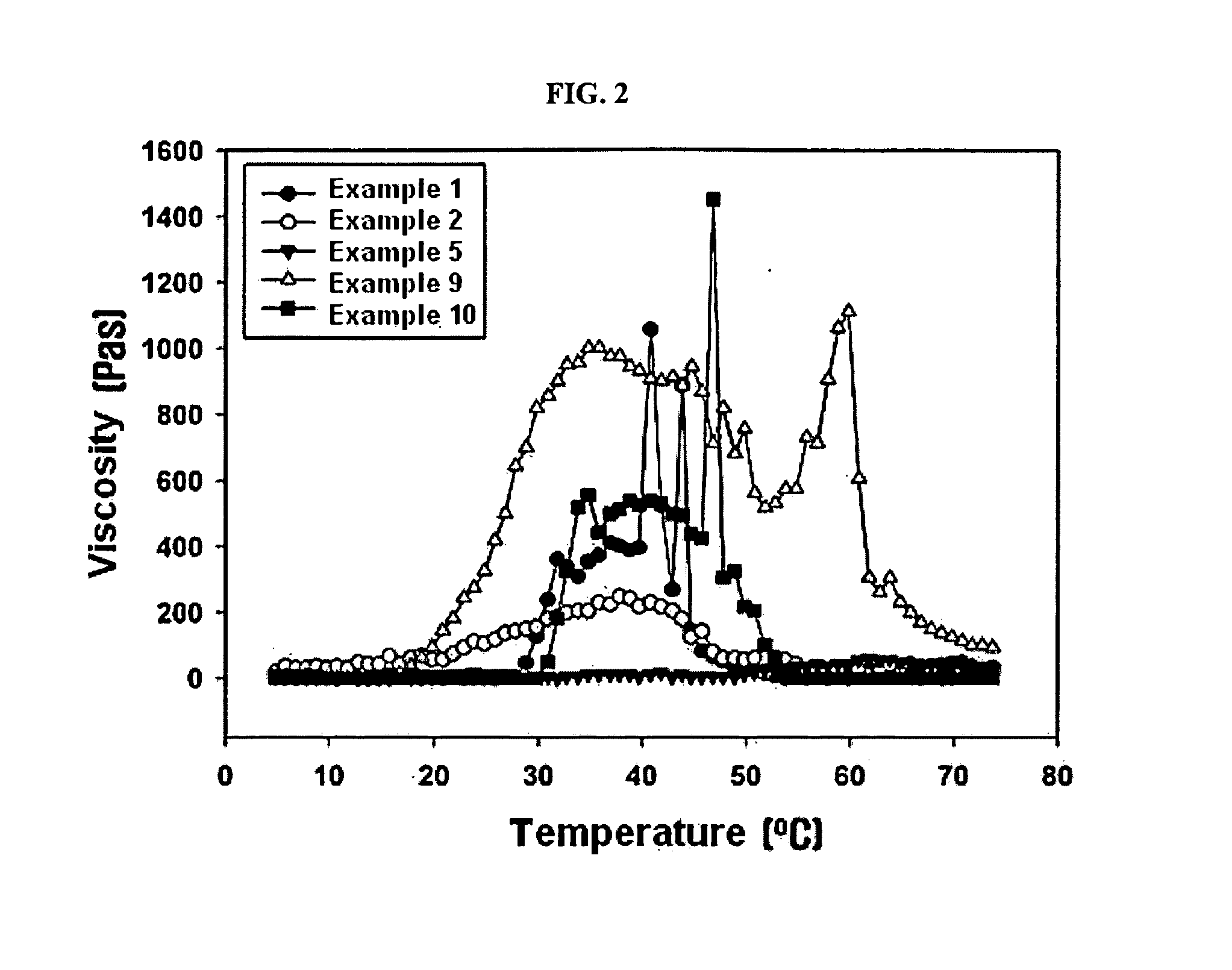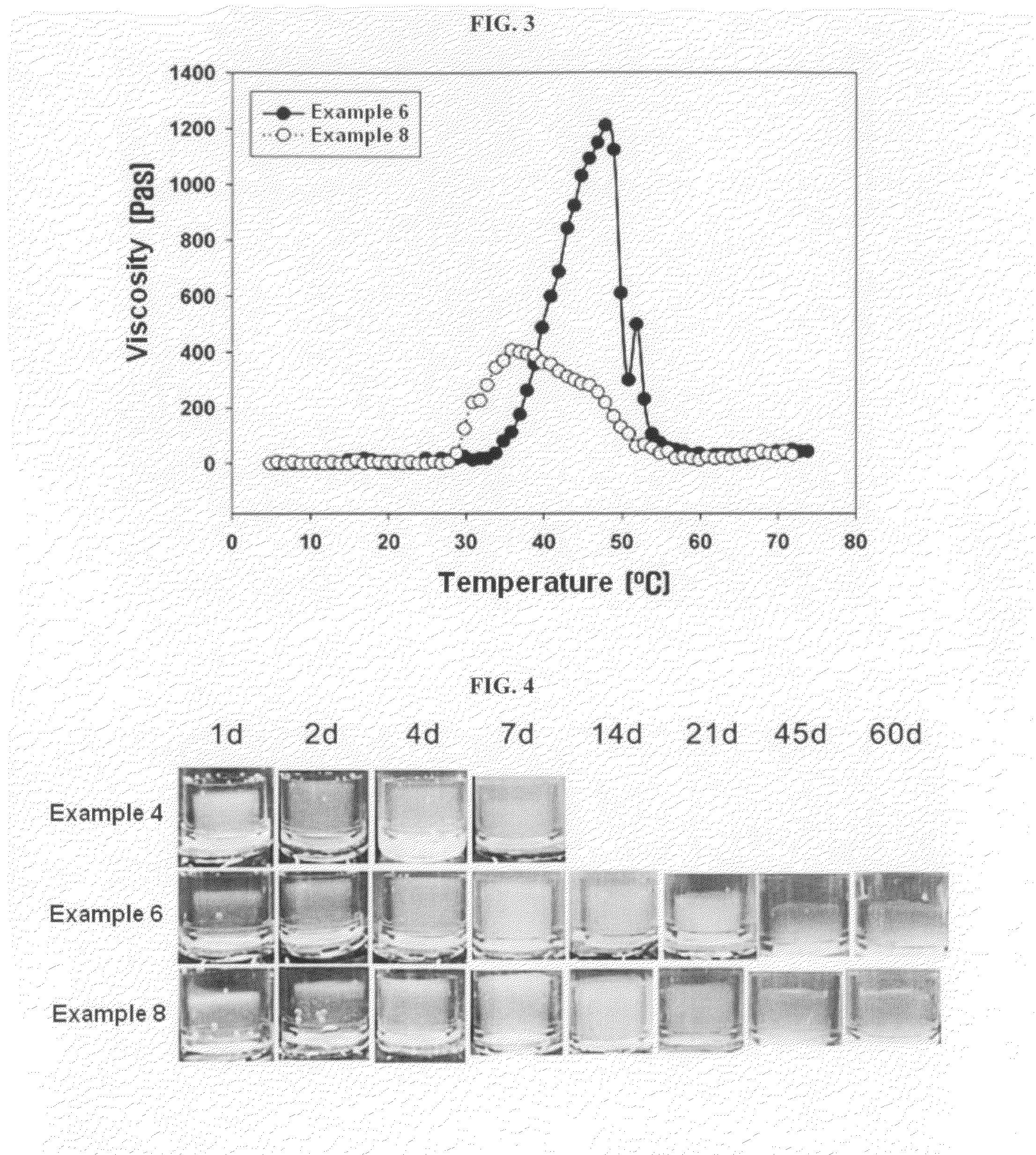Poly(organophosphazene) containing degradation controllable ionic group, preparation method thereof and use thereof
- Summary
- Abstract
- Description
- Claims
- Application Information
AI Technical Summary
Benefits of technology
Problems solved by technology
Method used
Image
Examples
example 1
[NP(I)1.22(P)0.57(H1)0.21]
[0091]Poly(dichlorophosphazene) (9.00 g, 77.66 mmol) was dissolved in tetrahydrofuran (300 ml), isoleucine ethyl ester hydrochloride (21.50 g, 109.89 mmol) and triethylamine (53.61 ml, 384.61 mmol) were added in the order in a dryice-acetone bath, and the mixture was reacted at room temperature for 48 h. To the reaction solution thus obtained was added a tetrahydrofuran solution (50 ml) wherein ethanolamine (1.40 g, 23.30 mmol) and triethylamine (6.49 ml, 46.60 mmol) were dissolved. Then, a tetrahydrofuran solution (100 ml) wherein aminomethoxy polyethylene glycol having the molecular weight of 750 (16.44 g, 15.53 mmol) and triethylamine (13.98 g, 69.04 mmol) were dissolved was added thereto and reacted at room temperature for 48 h. Subsequently, a tetrahydrofuran solution (50 ml) wherein aminomethoxy polyethylene glycol having the molecular weight of 750 (8.22 g, 7.76 mmol) and triethylamine (6.99 g, 34.52 mmol) were dissolved was further added thereto and...
example 2
[NP(I)1.18(P)0.42(H2)0.40]n
[0102]Poly(dichlorophosphazene) (9.00 g, 77.66 mmol), isoleucine ethyl ester (20.21 g, 103.29 mmol), aminomethoxy polyethylene glycol having the molecular weight of 750 (66.40 g, 88.53 mmol), propanolamine (0.58 g, 7.77 mmol), triethylamine (120.74 ml, 1.64 mol) and tetrahydrofuran (600 ml) were used according to the same procedure as Example 1 to give the final product [NP(I)1.18(P)0.42(H2)0.40]n (16.54 g, Yield 77%).
[0103]Hydrogen Nuclear Magnetic Resonance Spectrum (CDCl3, ppm):
[0104]δ 0.7˜1.1 (b, —NHCH(CH(CH3)CH2CH3)COOCH2CH3),
[0105]δ 1.1˜1.3 (b, —NHCH(CH(CH3)CH2CH3)COOCH2CH3),
[0106]δ 1.4˜1.8 (b, —NHCH(CH(CH3)CH2CH3)COOCH2CH3, b, —NHCH2CH2CH2OH),
[0107]δ 2.67˜3.2 (b, —NHCH2CH2CH2OH, —NH(CH2CH2O)16CH3),
[0108]δ 3.4 (s, —NH(CH2CH2O)16CH3),
[0109]δ 3.4˜3.8 (b, —NH(CH2CH2O)16CH3),
[0110]δ 3.9˜4.3 (b, —NHCH(CH(CH3)CH2CH3)COOCH2CH3)
[0111]Average molecular weight (Mw): 15000
example 3
[NP(I)1.36(P)0.41(H3)0.24]n
[0112]Poly(dichlorophosphazene) (2.00 g, 17.26 mmol), isoleucine ethyl ester (3.61 g, 18.47 mmol), pentanolamine (1.07 g, 10.35 mmol), aminomethoxy polyethylene glycol having the molecular weight of 750 (8.54 g, 11.38 mmol), triethylamine (16.37 g, 118.14 mmol) and tetrahydrofuran (400 ml) were used according to the same procedure as Example 1 to give the final product [NP(I)1.18(P)0.42(H3)0.40]n (5.37 g, Yield 76%).
[0113]Hydrogen Nuclear Magnetic Resonance Spectrum (CDCl3, ppm):
[0114]δ 0.7˜1.1 (b, —NHCH(CH3)CH2CH3)COOCH2CH3),
[0115]δ 1.1˜1.3 (b, —NHCH(CH(CH3)CH2CH3)COOCH2CH3),
[0116]δ 1.4˜1.8 (b, —NHCH(CH(CH3)CH2CH3)COOCH2CH3),[0117]b, —NHCH2CH2CH2CH2CH2OH),
[0118]δ 2.67˜3.2 (b, —NHCH2CH2CH2CH2CH2OH, —NH(CH2CH2O)16CH3),
[0119]δ 3.4 (s, —NH(CH2CH2O)16CH3),
[0120]δ 3.4˜3.8 (b, —NH(CH2CH2O)16CH3, b, —NHCH2CH2CH2CH2CH2OH),
[0121]δ 3.9˜4.3 (b, —NHCH(CH(CH3)CH2CH3)COOCH2CH3)
[0122]Average molecular weight (Mw): 15500
PUM
| Property | Measurement | Unit |
|---|---|---|
| temperature | aaaaa | aaaaa |
| degree of polymerization | aaaaa | aaaaa |
| concentration | aaaaa | aaaaa |
Abstract
Description
Claims
Application Information
 Login to View More
Login to View More - R&D
- Intellectual Property
- Life Sciences
- Materials
- Tech Scout
- Unparalleled Data Quality
- Higher Quality Content
- 60% Fewer Hallucinations
Browse by: Latest US Patents, China's latest patents, Technical Efficacy Thesaurus, Application Domain, Technology Topic, Popular Technical Reports.
© 2025 PatSnap. All rights reserved.Legal|Privacy policy|Modern Slavery Act Transparency Statement|Sitemap|About US| Contact US: help@patsnap.com



